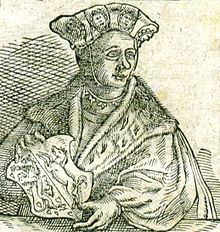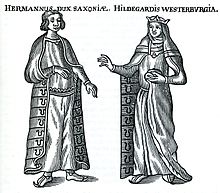Gertrudis de Sajonia (c.1030 - 4 de agosto de 1113), también conocido como Gertrudis Billung, fue condesa consorte de Holanda y condesa consorte de Flandes por el matrimonio. Ella fue regente de Holanda durante la minoría de su hijo.
Ella era hija del duque Bernardo II de Sajonia y Eilika de Schweinfurt. Se casó con el conde Florencio de Holanda (c.1017 - 28 de junio de 1061) cerca de 1050, y después de su muerte, su hijo Teodorico V se convirtió en conde de Holanda.
Dado que todavía era joven, se convirtió en regente. El obispo de Utrecht, Guillermo I, aprovechó esta circunstancia para ocupar las tierras que revindicaba en Holanda. Las pretensiones de Guillermo fueron confirmadas por dos diplomas del emperador Enrique IV, fechados en Kaiserswerth el 30 de abril y el 2 de mayo de 1064. Teodorico solo conservó las tierras al oeste del río Vlie y alrededor de la desembocadura del Rin.
Gertrudis y su hijo se refugiaron en las islas de Frisia (Zelanda), dejando que el obispo Guillermo ocupara el territorio disputado.
Bernard II (c. 995 – 29 June 1059) was the Duke of Saxony between 1011 and 1059, the third of the Billung dynasty as a son of Bernard I and Hildegard. Besides his position in Saxony, he had the rights of a count in Frisia.

Eilika of Schweinfurt (c. 1005 – 10 Dec aft. 1059) came from a Bavarian noble family. She was daughter of Margrave Henry of Schweinfurt and Gerberga of Gleiberg (970 – aft. 1036).[1][2]
- Ordulf, Duke of Saxony (1022 – 1072)
- Herman (d. 1086)
- Gertrude (d. 1115), married Floris I, Count of Holland in 1050 and Robert I, Count of Flanders in 1063
- Hedwig, married Engelbert I, Count of Spanheim (d. 1096)
- Ida (d. 31 Jul 1102), married Frederick, Duke of Lower Lorraine (d. 1065) with the county of La Roche as a dowry, and Count Albert III of Namur
Bernard I (c. 950 – 9 February 1011) was the Duke of Saxony between 973 and 1011, the second of the Billung dynasty, a son of Duke Herman and Oda. He extended his father's power considerably.
He fought the Danes in 974, 983, and 994 during their invasions. He supported the succession of Otto III over Henry the Wrangler. In 986, he was made marshal and in 991 and 995 he joined the young Otto on campaign against the Slavs. He increased his power vis-à-vis the crown, where his father had been the representative of the king to the tribe, Bernard was the representative of the tribe to the king [1]. Bernard died in 1011 and was buried in the Church of Saint Michael in Lüneburg.
Hildegard (died 1011), daughter of Henry I the Bald, Count of Stade (died 976).
Hermann Billung (900 or 912 – 27 March 973) was the Margrave of the Billung March from 936 until his death. The first of the Saxon House of Billung, Hermann was a trusted lieutenant of Otto I, Holy Roman Emperor.
Though never Duke of Saxony himself, while Otto (who was the enthroned Duke of Saxony) was in Italy from 961 until 972, Hermann served as Otto's personal representative in governing Saxony. Towards the end of his life, Hermann was the effective Duke in all but name.
Hermann died in 973, just two months before Otto's own death. Hermann's son Bernard I was named as the new Duke of Saxony by Otto I's son Otto II, the new Holy Roman Emperor. Hermann was probably the son of Billung. He was the younger brother of the Saxon count Wichmann the Elder. Hermann is generally counted as the first Billung duke (Herzog) of Saxony, but his exact position is unclear. The ducal Ottonian dynasty had risen to German royalty with the accession of Henry the Fowler in 919 and had to concentrate on countrywide affairs. At least in 961, when King Otto I of Germany marched against the Kingdom of Italy for the second time, he made Hermann the administrator (procurator regis) in his Saxon lands.

Billung IV von Stubenskorn Billung, Graf in Sachsen 900-67 Bruno III Billung, Graf in Sachsen y Gerberge van Hamaland
Ermengarde de Nantes 900-50 Witbert de Nantes y Adeltrude
Bruno III Billung, Graf in Sachsen 870-917 Billung II. Graf in Sachsen

No hay comentarios:
Publicar un comentario